In this article, you'll learn about the various contact management features we offer. We'll also provide examples of when you might use these features and where to find them in your account.
What is a contact?
A contact is a unique email address. You can create a contact with only an email address (no other information is needed). You cannot create a contact without an email address.
An email address counts as a single contact no matter how many lists the contact is subscribed to. You are only billed for the active contacts in your account (unsubscribed and bounced contacts do not count toward your contact total).
What is the Contacts Overview?
This is the page you see after clicking “Contacts” in the left-side menu. It displays a sortable, searchable list of your contacts.

Most bulk contact management takes place on the Contacts Overview page. From here, you can sort and search your contacts, bulk edit your contacts, do multi-dimensional searches on your contacts, and open up individual contact records.
Clicking a contact's name or email address will open their Contact Record.
What is a Contact Record?
The Contact Record aggregates and organizes all the information you've collected about a contact. From the Contact Record you can edit and add information and a variety of contact management features are available to you. You can subscribe and unsubscribe from lists, start and stop automations, and add and remove tags. From the contact record you can also see a stream of the contact's recent activity, create tasks, and add notes.

Filter/sort/adjust columns
The contact list that appears on the Contact Overview can be filtered and sorted.
You can filter the contacts by the list they are on, the tags they have, and their status (confirmed, unconfirmed, unsubscribed, or bounced).
You are able to display additional columns by clicking the gear icon in the upper right-hand corner of the contact list:
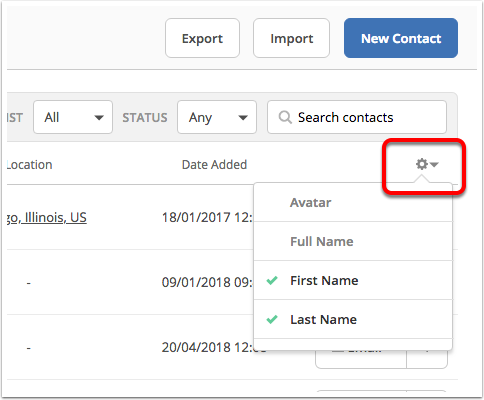
Search
You may need to find a single contact so that you can add information to their contact record, remove them from a list, or add them to an automation.
You can search for a single contact by their name or email address. To find a single contact, click into the search field that appears in the upper right-hand corner of the contact list:
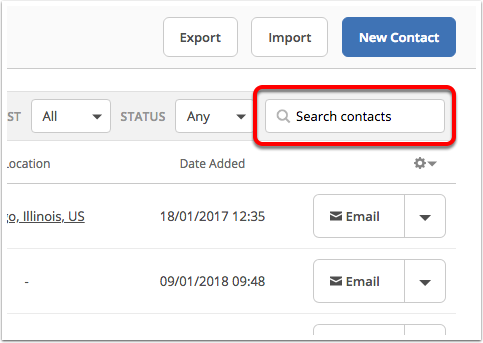
Advanced search
You may want to find groups of contacts that match specific conditions. For instance, you may want to see the contacts that have viewed a certain product on your site or all the contacts that live in a certain state of the U.S.
To use the Advanced Search feature, click into the search field located on the Contacts Overview page, then click "Advanced Search."

The segment builder will load. Here you can select from several different conditions and combine them with AND or OR logic to create your search. For example, you can search for contacts using any of the following conditions:
- Tags added to contacts.
- Visits to pages of your website.
- Clicks on specific links in your campaigns.
- Contact data including custom fields you've created.
- Contact location.
- Events you are tracking.
- Where the contact was referred from.
- The device they used to visit your site.
- And more.
After you've identified the contacts you are looking for, the Advanced Search can be saved so you can quickly reuse it or the conditions can be used to create a segment of contacts so you can send campaigns to them.

Bulk Editor
The Bulk Editor is a time-saving feature that allows you to manage groups of contacts. You are able to:
- Add to or unsubscribe from lists
- Add to or remove from automations
- Add or remove tags
- Update fields
After you've found a group of contacts with the Advanced Search feature, you can use the Bulk Editor to perform actions on them without having to modify each contact one-by-one.

Manage tags
Tags can be added to your contacts as a way to organize and group them. Tags can also add information to your contact (in addition to the use of default and custom fields).
The Manage Tags feature allows you to create and edit your tags. You can merge duplicate tags and also describe a tags purpose (so that you don't forget why a tag was created or what it indicates).
To access the Tag Manager, click "Manage Tags" from the Contacts Overview page.
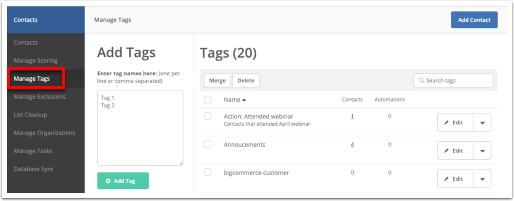
Custom Contact Fields
Custom contact fields are used to store additional information about your contacts. The custom fields that make sense for your business may be different than what someone else needs, so we've made custom fields very flexible and you can create an unlimited amount of fields.
There are a variety of field types you can use to store different types of data:
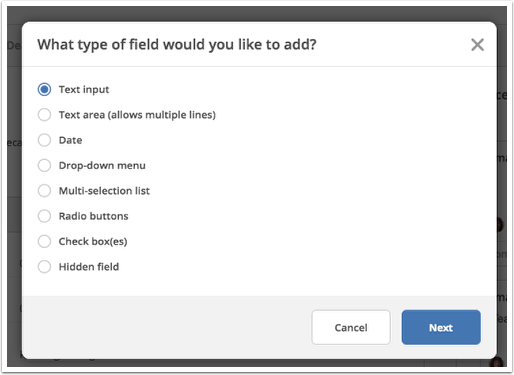
You can also add these fields from the Contact Record.

Contact Scoring
Contact scoring gives you a numerical score that can indicate the contact's fit for your product and level of engagement so that you can prioritize your leads and treat them differently depending on their score. It's a flexible feature that is useful to both marketers and salespeople and has many applications throughout the customer lifecycle.
To manage your contact scores, click “Manage Scoring” from the Contact Overview page.

Database Sync
Database Sync allows you to quickly import contacts from a MySQL, MSSQL, or PostGreSQL database.
To access Database Sync to import your contacts, click "Database Sync" from the Contacts Overview page.
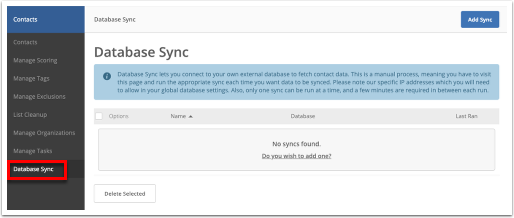
Manage Exclusions
You may not want to send to groups of email addresses. For instance, you might find that you are getting poor quality contacts from certain domain names. With our exclusion feature, you can block those email addresses so that no emails get sent to them.
To access the Exclusions List, click "Manage Exclusions" from the Contacts Overview page.
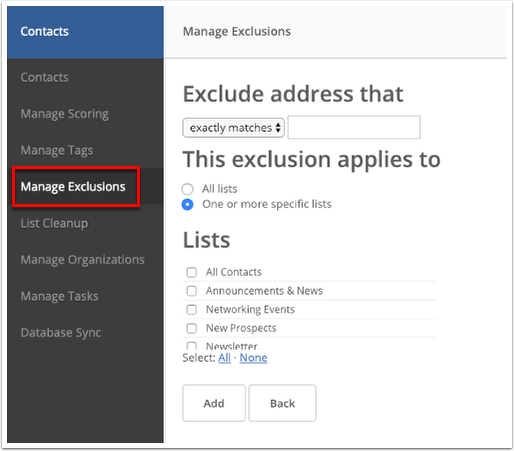
List Cleanup Tool
The List Cleanup tool helps you delete contacts from your list(s) that you no longer need.
For example, you can use the List Cleanup tool to:
- Delete all contacts with a particular status from all lists
- Delete all contacts with a "Subscribed" status from selected lists
- Delete all contacts with an "Unsubscribed" status from selected lists
- Delete all contacts with an "Unconfirmed" status from selected lists
- Delete all contacts with a "Bounced" status from selected lists
- Delete all contacts with any status from selected lists
- Delete specific email addresses (contacts) from selected lists
To access the List Cleanup tool, click "List Cleanup" from the Contacts overview page.

Opmerkingen
0 opmerkingen
Artikel is gesloten voor opmerkingen.